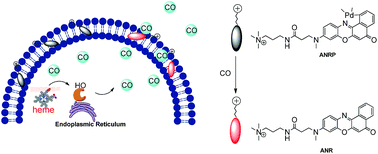当前位置:
X-MOL 学术
›
Chem. Sci.
›
论文详情
Our official English website, www.x-mol.net, welcomes your
feedback! (Note: you will need to create a separate account there.)
A cell membrane-anchored fluorescent probe for monitoring carbon monoxide release from living cells†
Chemical Science ( IF 7.6 ) Pub Date : 2018-10-10 00:00:00 , DOI: 10.1039/c8sc03584a Shuai Xu 1 , Hong-Wen Liu 1, 2 , Xia Yin 1 , Lin Yuan 1 , Shuang-Yan Huan 1 , Xiao-Bing Zhang 1
Chemical Science ( IF 7.6 ) Pub Date : 2018-10-10 00:00:00 , DOI: 10.1039/c8sc03584a Shuai Xu 1 , Hong-Wen Liu 1, 2 , Xia Yin 1 , Lin Yuan 1 , Shuang-Yan Huan 1 , Xiao-Bing Zhang 1
Affiliation

|
Carbon monoxide (CO) acts as an important gasotransmitter in delivering intramolecular and intermolecular signals to regulate a variety of physiological processes. This lipid-soluble gas can freely pass through the cell membrane and then diffuse to adjacent cells acting as a messenger. Although many fluorescent probes have been reported to detect intracellular CO, it is still a challenge to visualize the release behavior of endogenous CO. The main obstacle is the lack of a probe that can anchor onto the cell membrane while having the ability to image CO in real time. In this work, by grafting a polar head onto a long and linear hydrophobic Nile Red molecule, a cell membrane-anchored fluorophore ANR was developed. This design strategy of a cell membrane-anchored probe is simpler than the traditional one of using a long hydrophobic alkyl chain as a membrane-anchoring group, and endows the probe with better water solubility. ANR could rapidly bind to the cell membrane (within 1 min) and displayed a long retention time. ANR was then converted to a CO-responsive fluorescent probe (ANRP) by complexation with palladium based on a metal palladium-catalyzed reaction. ANRP exhibited a fast response to CO with a 25-fold fluorescence enhancement in vitro. The detection limit was calculated to be 0.23 μM, indicating that ANRP is sensitive enough to image endogenous CO. Notably, ANRP showed excellent cell membrane-anchoring ability. With ANRP, the release of CO from HepG2 cells under LPS- and heme-stimulated conditions was visualized and the cell self-protection effect during a drug-induced hepatotoxicity process was also studied. Moreover, ANRP was successfully applied to the detection of intracellular CO in several cell lines and tissues, and the results demonstrated that the liver is the main organ for CO production, and that cancer cells release more CO from their cells than normal cells. ANRP is the first membrane-anchored CO fluorescent probe that has the ability to reveal the relationship between CO release and diseases. It also has prospects for the studying of intercellular signaling functions of CO.
中文翻译:

用于监测活细胞释放一氧化碳的细胞膜锚定荧光探针†
一氧化碳 (CO) 作为重要的气体递质,传递分子内和分子间信号以调节多种生理过程。这种脂溶性气体可以自由地穿过细胞膜,然后扩散到邻近的细胞,充当信使。尽管已报道许多荧光探针可检测细胞内 CO,但可视化内源 CO 的释放行为仍然是一个挑战。主要障碍是缺乏既能锚定在细胞膜上,又能对细胞内 CO 进行成像的探针。即时的。在这项工作中,通过将极性头接枝到长且线性的疏水性尼罗红分子上,开发了细胞膜锚定的荧光团ANR 。这种细胞膜锚定探针的设计策略比传统的使用长疏水烷基链作为膜锚定基团的设计策略更简单,并且赋予探针更好的水溶性。ANR可快速与细胞膜结合(1分钟内)并表现出较长的保留时间。然后,基于金属钯催化反应,通过与钯络合,将ANR转化为 CO 响应荧光探针 ( ANRP )。ANRP对 CO 表现出快速响应,体外荧光增强 25 倍。计算出的检测限为0.23 μM,表明ANRP对内源CO成像足够敏感。值得注意的是,ANRP表现出优异的细胞膜锚定能力。利用ANRP,可以可视化在 LPS 和血红素刺激条件下 HepG2 细胞释放 CO,并研究药物诱导的肝毒性过程中细胞的自我保护作用。此外,ANRP还成功应用于多种细胞系和组织中细胞内CO的检测,结果表明肝脏是CO产生的主要器官,癌细胞从细胞中释放的CO比正常细胞更多。ANRP是第一个膜锚定的CO荧光探针,能够揭示CO释放与疾病之间的关系。对于CO细胞间信号传导功能的研究也具有广阔的前景。
更新日期:2018-10-10
中文翻译:

用于监测活细胞释放一氧化碳的细胞膜锚定荧光探针†
一氧化碳 (CO) 作为重要的气体递质,传递分子内和分子间信号以调节多种生理过程。这种脂溶性气体可以自由地穿过细胞膜,然后扩散到邻近的细胞,充当信使。尽管已报道许多荧光探针可检测细胞内 CO,但可视化内源 CO 的释放行为仍然是一个挑战。主要障碍是缺乏既能锚定在细胞膜上,又能对细胞内 CO 进行成像的探针。即时的。在这项工作中,通过将极性头接枝到长且线性的疏水性尼罗红分子上,开发了细胞膜锚定的荧光团ANR 。这种细胞膜锚定探针的设计策略比传统的使用长疏水烷基链作为膜锚定基团的设计策略更简单,并且赋予探针更好的水溶性。ANR可快速与细胞膜结合(1分钟内)并表现出较长的保留时间。然后,基于金属钯催化反应,通过与钯络合,将ANR转化为 CO 响应荧光探针 ( ANRP )。ANRP对 CO 表现出快速响应,体外荧光增强 25 倍。计算出的检测限为0.23 μM,表明ANRP对内源CO成像足够敏感。值得注意的是,ANRP表现出优异的细胞膜锚定能力。利用ANRP,可以可视化在 LPS 和血红素刺激条件下 HepG2 细胞释放 CO,并研究药物诱导的肝毒性过程中细胞的自我保护作用。此外,ANRP还成功应用于多种细胞系和组织中细胞内CO的检测,结果表明肝脏是CO产生的主要器官,癌细胞从细胞中释放的CO比正常细胞更多。ANRP是第一个膜锚定的CO荧光探针,能够揭示CO释放与疾病之间的关系。对于CO细胞间信号传导功能的研究也具有广阔的前景。









































 京公网安备 11010802027423号
京公网安备 11010802027423号